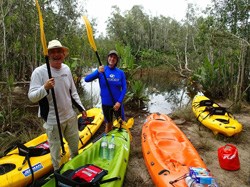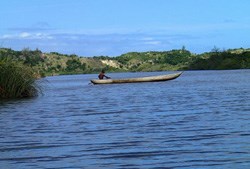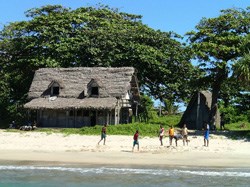Yes, you can have your kayak and...

Our first night in Antananarivo was short-lived - we arrived late and left well before dawn to catch a connecting flight but not before the most fabulous dinner at the upscale and up tempo Cafe de la Gare at the train station which seethed with the sex appeal only found in balmy tropical cities.
Even pre-dawn, the streets of Tana, so called by the locals after getting its name from the thousand men its founding king left to protect it in the 1600's, is busy - people jogging along the rice paddies, roasting chicken; piling up plantains and fruit for sale. This Sunday morning many were going to church: There are many cultural groupings in Madagascar based on the original tribes each with different language inflections and beliefs. While many are Christian, many still worship the sacred ancestors of the animists which even those who identify themselves as Christian seem to do in a syncretic way.
I wished we had longer to enjoy the hotel Résidence Lapasoa positioned in one of the oldest neighbourhoods on top of a hill. Originally a colonial mansion, the property has now expanded to include other buildings connected at the hip.

Flying with Air Madagascar to Fort Dauphin, on the South East Coast of Madagascar takes about as long as from Cape Town to Johannesburg. This gives a sense of how large Madagascar is - the world's fourth largest Island.
Be ready to fill in a form ... then another ... and ...
Having a local guide and driver is essential. Not only do they drive on the French side of the road, but there are neither street names nor road signs. And, here's the kicker, the bureaucracy requires an aide to smooth things over for you. There is an incessant and irritating amount of form-filling-in, so along with your wits, you'd better have your travelling documentation including the address and phone number where you are staying and a pen, at hand.
Fort Dauphin, named after Louis IV while he was still dauphin, is a sleepy, crumbling village on a Sunday with little to distract one. Not to be missed is lunch at the seaside in a palm-fringed timber structure that chalks up the day's specials, all in French, on a board. For about R70 a head, you will feast on local fish with Madagascar Pepper sauce, drink bottled water (don't touch the stuff from the taps) and drink superb coffee. The Ankoba Beach aka Chez Marceline is closed Mondays and only serves lunch.

We walked from our hotel, the charmless but perfectly adequate Kaleta Hotel. What it lacks in personality it makes up for in amenities and we valued the air-conditioner and mini bar in the room. Many properties offer free Wi-Fi but the connection in Fort Dauphin is so slow and erratic that it teases more than it delivers. It has a nice pool and small gym and our room, 34, was large and very comfortable but I would have preferred a shower to the bath.
Not perhaps for everyone
Cock fighting is a weekend favourite and there's a ring right next door to Ankoba which, if you can stomach it, is your post-lunch entertainment. I prefer the beach and watching the many football games that happen as the coast curves back into the rock face from the newly built Rio Tinto titanium mine.
Even by luxury 4X4 the trip to Lokoro, even further South-East is a tiring one but this is the sacrifice to be among the very few who get to experience the littoral rainforests and exquisite coast. With the promise of a stay at the deluxe Manafiafy Beach Resort at the end of our kayaking we entered the river.

As first time kayakers, lessons how to steer would have been useful. There is, for example, a right way to hold the paddle - the pointy-shape must face upwards. Also, not obvious to newbies, is that back-paddling is the easiest way to stop or to turn and that when two are in the kayak the one in the front is the engine and the one at the rear steers the kayak. Take longer strokes on the opposite side to the headwind to help you keep going straight and rather than pull the paddle into the water, use leverage and push it away from you - pretty soon a rhythm develops. Gloves are useful to protect your hands from the sun and also to prevent a blister from developing in your palm.
Disappearing like a ghost
We were testing a Drift HD Ghost Camera, an extreme sports-designed unit that is waterproof and shock proof. We thought we'd secured it to the tip of our kayak so that we could share all the action of our paddle adventure with our friends back home. However, while the purpose-built suction unit made it impossible to dislodge the camera by pulling it, crashing into a low branch managed to knock it off and into the river with ease. The river was too deep and flowing too strongly to try to retrieve the camera. Tensions between my spouse and I were now peaking so in the interests of a long and happy marriage we split and joined other more experienced kayakers.
As a first-timer I was amazed that others, including seasoned kayakers and surfers, were as tired as I was at the end of the journey and I certainly felt more confident because of it.

After a picnic lunch prepared by French-trained chefs and served along the river bank, we began the trek through a village, up and down a hill and onwards through a deserted beach to where we would camp for the night.
This part of Madagascar is greener than green. Rice grows everywhere but it is surrounded by palms and the iconic Travellers Tree which is also the emblem for Air Madagascar. The flora looks a lot like coastal fynbos and what they call their periwinkle flower is something we often see here.
Little change
It doesn't seem as if village life has changed over the years. Their palm roofed timber houses, like the pirogues they fish from, are carved from local trees. The girls wear their hair in plaits which they form into buns above their ears, much like headphones, while the boys and men are simply dressed. These villagers live off the water and by collecting and smashing rocks and stones. There is no electricity or sewage as we expect it.

Not having flushing toilets while camping was one of my major worries. It wasn't nearly as uncomfortable as I imaged - the staff digs a deep hole and positions a solid throne toilet seat above it with a woven palm frond curtain around it. The shower worked amazingly well. Also enclosed by a woven palm covering, a large bladder is filled with warm water and suspended above the shower unit.
We arrived on foot to our camp site late in the afternoon and the fireflies seemed to beckon us into the trees of the surrounding forest. The three-man tents were comfortable enough and bedding, towels and toiletries were all neatly arranged. Dinner, like all the food we experienced in Madagascar, was excellent but after the day kayaking we headed early to bed with fireflies and glowing lanterns to show the way.

This sites real appeal was only evident the next morning - a superb tropical swimming beach with such warm, clear water we skipped our shower.
Another day kayaking but rather than crossing the rivers we explored tributaries, deltas and mazes of delicious monsters and mangroves. This was the most picturesque of our visit thus far and the water so calm that the cloudless sky was perfectly reflected in it.
We waved to local fisherman in their pirogues, then to a group of girls harmonising while casting their nets until we came upon the banks of a village, so secluded that we terrified the young children playing in the water. Their screams at seeing us brought the whole village out.
Something to remember
Our night's camp site delivered a sunset over the river and rainforests beyond that I will never forget. I won't forget the rain either which pelted our tent without stop until morning.
Just half a day's more kayaking to complete the 45km from Lokoro to Manafiafy Beach and Forest Resort and I arrived feeling as if I'd completed a Hero's Journey and slaughtered some personal dragons along the way.
This is an eco-sensitive lodge that treads lightly on the beach and forest on which it sits but delivers all of the luxury you can want. With vast suites with private decks and direct beach access, this is the sort of place you want to spend a few days in simply swaying from side to side in the hammocks. There is a spa pavilion but we had a massage in our suite. The only thing I wanted for in Manafiafy was more time.
A short boat ride to 16km beach nearby to snorkel and swim with the tropical fish was another standout experience as was a night hike into the forest in search of Lemurs which, deep into its centre with the sweaty and heavy leaves of the trees surrounding us, unlocked my primal survival instincts - I had to speedily leave the forest to avoid freaking out totally.
Back into Tana and after a stay at the truly fabulous Le Pavillon de l'Emyrne and a great dinner at nearby Kudeta we had to return to South Africa.
Along with the miniature cars made from Perrier tins, beautiful Ammonite fossilised shells and pocketfuls of pepper, vanilla and coffee, I returned with wonderful memories and that deep feeling of satisfaction only from achieving something I set out to do.
Getting there:
Fly Air Madagascar from Johannesburg to Tana and then to Fort Dauphin. Jenman African Safaris will take care of everything including your South African airport transfers and pre and post accommodation bookings.
For more information go to http://www.jenmansafaris.com and www.travel2madagascar.com or Call Ruth on +27 (0) 21 683 7826 or email moc.sirafasnamnej@ofni.
About Brian Berkman
- More than an apple a day in Grabouw's tourism future - 9 Feb 2018
- At the very top of the top - 1 Nov 2016
- Bring your own slippers and explore deep into the heart of a luxury villa - 31 Oct 2016
- The key to luxury villa accommodation in the Winelands - 27 Oct 2016
- Fly with the eagles and trot with the elephants - 18 Oct 2016
View my profile and articles...